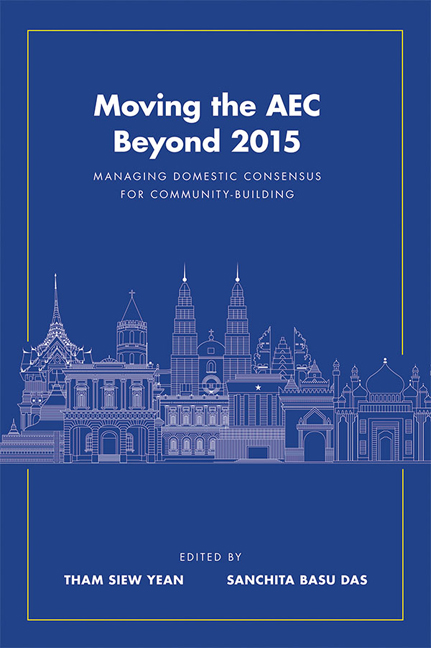Book contents
- Frontmatter
- Contents
- Foreword
- Preface
- Acknowledgements
- Abbreviations
- About the Contributors
- 1 Introduction: Economic Interests and the ASEAN Economic Community
- 2 ASEAN Economic Cooperation and Its Political Realities
- 3 Indonesia's Implementation of Facilitation and Harmonization Measures under the AEC
- 4 The AEC and Domestic Challenges in Malaysia: Examining the Liberalization of Services in AFAS
- 5 The Philippines and the AEC Beyond 2015: Managing Domestic Challenges
- 6 The AEC Beyond 2015: Implementation and Challenges for Singapore
- 7 Moving the AEC Beyond 2015: Managing Domestic Economic Interests in Thailand
- 8 Managing Domestic Consensus for ASEAN Community Building in Vietnam
- Index
5 - The Philippines and the AEC Beyond 2015: Managing Domestic Challenges
Published online by Cambridge University Press: 06 January 2018
- Frontmatter
- Contents
- Foreword
- Preface
- Acknowledgements
- Abbreviations
- About the Contributors
- 1 Introduction: Economic Interests and the ASEAN Economic Community
- 2 ASEAN Economic Cooperation and Its Political Realities
- 3 Indonesia's Implementation of Facilitation and Harmonization Measures under the AEC
- 4 The AEC and Domestic Challenges in Malaysia: Examining the Liberalization of Services in AFAS
- 5 The Philippines and the AEC Beyond 2015: Managing Domestic Challenges
- 6 The AEC Beyond 2015: Implementation and Challenges for Singapore
- 7 Moving the AEC Beyond 2015: Managing Domestic Economic Interests in Thailand
- 8 Managing Domestic Consensus for ASEAN Community Building in Vietnam
- Index
Summary
INTRODUCTION
Constant pressure to stay competitive built the momentum for ASEAN Leaders to conceptualize the ASEAN Economic Community (AEC) as a vision for deepening and broadening regional economic integration in 2003. The AEC is characterized by four pillars: a single market and production base; a highly competitive economic region; a region of equitable economic development; and a region fully integrated into the global economy (ASEAN Secretariat 2009). While the original timeline for the AEC was 2020, it was subsequently accelerated to the end of 2015 in response to the confluence of regional as well as global challenges that confronted the region (Austria 2015).
As a founding member of ASEAN, the Philippines has embraced the challenge of moving towards attaining the AEC vision because it is consistent with the overarching goal of increasing the country's competitiveness in an era of globalization and regional economic integration. The Philippines has implemented substantial market-oriented reforms covering liberalization, facilitation, privatization and deregulation since the 1980s. These were carried out in various stages involving unilateral, regional as well as multilateral approaches (Austria 2003). Yet despite these policy reforms, the country has been affected by the boom-bust cycle of economic growth, lagging behind its neighbours in the region after more than three decades of reforms. Nevertheless, for the past three years, the country's growth performance was not only higher than its past records, but it was also the highest in the region, after China. However, it remains to be seen if this performance is sustainable.
In fact, the country's expected structural transformation from agriculture to manufacturing did not take place (Aldaba 2014). The contribution of the manufacturing sector to the economy remained at less than a quarter of GDP, in contrast to Thailand's experience where the sector gradually evolved to become the driver of economic growth. The automobile industry was one of the early industries promoted by the Philippines in its bid for industrialization in the 1980s. This was logical as the country participated in the changing landscape of global production networks in East Asia, whereby the labour-intensive segments of technologically complex production processes are separated from the capital- and skill-intensive segments and located in developing countries, linked through international sub-contracting and outsourcing arrangements (Austria 2013; Aldaba 2008; Rosellon and Medalla 2011).
- Type
- Chapter
- Information
- Moving the AEC Beyond 2015Managing Domestic Consensus for Community-Building, pp. 94 - 121Publisher: ISEAS–Yusof Ishak InstitutePrint publication year: 2016



